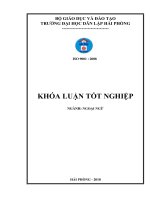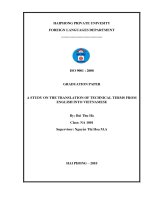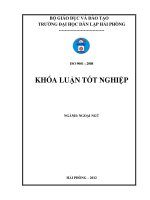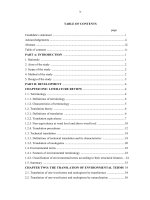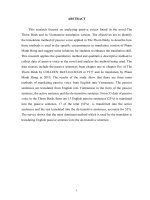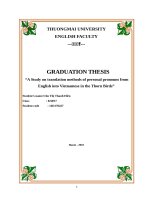The equivalent and non equivalent translation of weather idioms from english into vietnamese graduation paper, major translation interpretation
Bạn đang xem bản rút gọn của tài liệu. Xem và tải ngay bản đầy đủ của tài liệu tại đây (494.48 KB, 63 trang )
THE EQUIVALENT AND NON-EQUIVALENT
TRANSLATION OF WEATHER IDIOMS FROM
ENGLISH INTO VIETNAMESE
Acknowledgements
On the completion of this paper, I am grateful to many people.
First, I would like to express my sincere gratitude to my instructor for her
advice and encouragements during my process of completing this paper. Without
her help, this paper could barely become into being.
Next, I would like to express my gratefulness to all teachers in Department of
Foreign Languages for their valuable lectures for four years. Without these
constructive lectures that have provided me a good background, I could hardly
complete this paper with such effectiveness.
Last, I would like to thank my family and friends for their continuous support
and assistance during the course of my writing this paper.
Ho Chi Minh, June 2019
Pham Hoang Bao Khanh
Abstract
Language is not only a basic method of communication but also a reflection
of a nation’s cultures and customs. Its unique beauty was formed, developed
throughout English history and influenced by different characteristics such as
histories, traditions, climates, weather, manufacturing processes, and other aspects.
For this reason, each language has some special expressions, especially idioms,
making it hard, or even impossible, to explain and translate to another language.
Idiomatic expressions play a significant role in the language system of all
nations. The diverse range of idioms spreads every field in life. Idioms are used in
both formal and informal situations, in both writing and speaking, in literature and
daily life. Therefore, every language learner should, or even must, learn idioms when
studying a foreign language. It is even more important for translators to learn and
comprehend idioms of foreign languages because it improves our information and
knowledge of our mother tongue as well as our understanding in both cultures and
traditions.
Table of contents
CHAPTER I: INTRODUCTION
1. Rationale of the study ......................................................................................6
2. Scopes of the study..........................................................................................7
3. Methods of the study .......................................................................................7
4. Aims of the study ............................................................................................7
5. Design of the study..........................................................................................8
CHAPTER II: LITERATURE REVIEW ...............................................................9
CHAPTER III: RESEARCH DEVELOPMENT
1. Theoretical background ...................................................................................14
1.1. Translation .........................................................................................14
1.1.1. Definition ............................................................................14
1.1.2. Methods of translation .........................................................15
1.1.3. Types of translation .............................................................20
1.2. Idioms ................................................................................................22
1.2.1. Definition ............................................................................22
1.2.2. Common features of idioms .................................................23
1.2.3. Classification of idioms .......................................................26
1.3. Equivalence and non-equivalence.......................................................28
1.3.1. Definition ............................................................................28
1.3.2. Types of equivalence ...........................................................30
1.3.3. Common non-equivalent types .............................................33
2. Causes affect in translating weather idioms from English into Vietnamese
2.1. Language ...........................................................................................44
2.1.1. What is language? ................................................................44
2.1.2. The relationship between language and translation...............45
2.2. Culture ...............................................................................................46
2.2.1. What is culture? ...................................................................46
2.2.2. The relationship between culture and language ....................47
2.2.3. The relationship between culture and translation ..................48
3. List of equivalent and non-equivalent weather idioms .....................................50
3.1. Non-equivalent translation of weather idioms.....................................50
3.2. Equivalent translation of weather idioms ............................................52
CHAPTER IV: IMPLICATIONS, SUGGESTIONS, AND CONCLUSION
1. Implications ....................................................................................................57
1.1. In teaching .........................................................................................57
1.2. In translation ......................................................................................58
2. Suggestions .....................................................................................................60
3. Conclusion ......................................................................................................60
References
CHAPTER I: INTRODUCTION
1. Rationales of the study
In the past ten years, English has become an essential, significant language
beside our mother tongue. With the growth of our country, numerous of foreign
companies have been coming to Vietnam for trade, business, cooperation,
investment, etc.. Therefore, the importance of using an international language
becomes the first priority - English. Additionally, in any negotiations, conferences,
meetings, etc. between the Vietnamese and the foreigners, using English fluently is
“a must”. Nevertheless, communications, which include using idioms, is a two-way
process and this is one of the reasons the Vietnamese should grasp English idioms
as much as possible.
Another problem when Vietnamese people learn English is we only focus on
grammar, vocabulary, tenses, spelling, pronunciation, etc., but not the idioms
which are one of the foundations to master a language. Idioms are one of the most
used phrases in daily life both speaking and writing because it is a simple method to
express our thoughts, emotions, desires, etc. helping us communicate and understand
more the way English natives use their language. However, to completely
understand another language through its figures of speech is quite a challenge since
some idioms do not have the similar or equivalent phrases in our own language.
This is not mentioned some are too difficult for foreign learners to know how to use
correctly in which situation or even understand.
As a student’s majoring in translation - interpretation, I determine to find the
equivalent and non-equivalent English idioms related to weather when translating
into Vietnamese. In addition, the reasons make it difficult to find similar phrases
from English to Vietnamese will be figured out in this research paper.
6
2. Scopes of the study
The research paper will focus on general view of translation, idioms, and
equivalence. Besides, I will point out the causes leading to the differences between
English and Vietnamese idioms in translation as well as a list of equivalent and nonequivalent idioms will be given. However, due to my limitation of knowledge and
the narrow of my topic which are weather idioms, it may prevent language learners
from expand their information and improve their English.
3. Methods of the study
Due to my topic, the methods used in this research are mostly collected from
textbooks, materials, and studies done before combined with comparative and
contrastive analysis. The research will begin with the definition of translation,
idioms, and equivalence. The information is collected from English and Vietnamese
dictionaries, textbooks and studies related to equivalence in translation, and the
Internet. The next part of my research is to point out the causes affect translation
English idioms related to weather into Vietnamese.
4. Aims of the study
Firstly, this research is to provide an overall definition of translation, idiom,
and equivalence that is extremely useful and practical for students whose major is
translation and interpretation. It helps students expand and reinforce their knowledge
of translation and idioms as well as equivalence in translation and its importance in
translation.
Secondly, it encourages and inspires people to enrich their own knowledge
through learning English idioms. By learning English idioms, they also learn
Vietnamese equivalent phrases, which is a perfect way to conserve our own
7
language. Moreover, it gives learners a chance to practice using English weather
idioms more in daily life.
Finally, this paper helps translators recognize the importance of idiomatic
expressions in translation because authors always embellish their creation and works
by adding figures of speech, idiomatic expressions, slangs, etc.
5. Design of the study
The research will be divided into four parts:
First is introduction. This part contains rationale, scopes, methods, aims, and
design of the study.
Second is literature review. This part is the summary of my references
quoted to support my point of view in this research.
Third is research development. In this part, a general view of translation,
idioms, and equivalence are mentioned as well as the reasons making it hard to find
the equivalent English idioms related to weather translation in Vietnamese.
Fourth are implications, suggestions, and conclusion. In this part, there are
my implications of this research and suggestions for any further studies in the
future.
8
CHAPTER II: LITERATURE REVIEW
Idioms are one of the most important and difficult parts in every language
because they contain a massive amount of information related to cultures and
traditions. It is necessary for language learners who desire to master a foreign
language to learn its inseparably significant part. Another reason learners should
possess their own collection of idioms is because of its frequent use in daily life.
Sometimes, it is hard for either the natives to explain a full meaning of an idiom for
learners or learners to understand completely and use correctly in an appropriate
moment or situation. To truly understand and use a foreign language competently, it
is undeniable that language learners have to study the cultures, traditions, and
customs of that language. Understanding these problems, Jennifer Seidl published
a book called “English idioms and how to use them” in 1978 in order to help foreign
learners to understand the meaning of idioms, learn them systematically, and use
them properly and efficiently. In 2010, Michael McCarthy and Felicity O’Dell also
published “English idioms in use: Advanced” to “help you take your knowledge of
idioms to a more advanced level.” [20, tr.4]
Besides learning idioms, many theories and definitions of translation, idioms,
and equivalence in translation are mentioned, which are three central focuses, in
order to introduce an overall view of these three concepts. Since this paper is deeply
related to the theory of translation equivalence, theories, concepts, and ideas of three
definitions above hold a contributory role in providing, expanding, and consolidating
useful information for readers, especially who are interested in the theory of
translation and translation equivalence. Therefore, many notable theories of
translation and translation equivalence from famous authors, such as Peter
Newmark, Eugene Nida, John Cunnison Catford, are presented and recited. In terms
of idioms, contributions from many different linguists, such as Bobrow and Bell,
9
Yong and Peng, Heacook, etc., are mentioned and quoted. In terms of equivalence,
important, prominent works from Eugene Nida, John Cunnison Catford, Mona
Baker are introduced.
In terms of translation theory, “A Textbook of Translation” by Peter Newmark
(1988) introduced strategies and methods used in translation. It is very useful for
students to have a basic view and learn systematically as a translator. He introduced
full, logical steps to do before actually starting translating from analyzing a text,
learning and grasping the process of translation to the language functions, translation
methods. Moreover, along with the standard methods used in translation, he also
mentioned other translation procedures which are either another method of
translation or an effect on a translated text. His contribution in translation theory is
recognized worldwide and applied in teaching translation in many countries.
Another significant contribution to the theory of translation belongs to Eugene
Nida. His two remarkable “Towards a science of translating” and “The theory and
practice of translation” contribute valuable and practical methods to the theory of
translation. In “Towards a science of translating” books, following Jakobson, Nida
divided translation into three parts that are intralingual translation, interlingual
translation, and intersemiotic translation. In the same book, Nida also mentioned
many different aspects in the translation process that translators have to deal with,
such as different features of meaning (linguistic meaning, referential meaning, and
emotive meaning), the correspondences and contrasts between two languages, the
translation procedures as well as proper techniques of adjustment translators apply
in translation. Moreover, in “Towards a science of translating”, he had a separate
chapter to discuss the role of translators in translation. In this chapter, he not only
pointed out the model of translators’ role but also some basic requirements for
translators as well as the motives of translators in translation. He summarized in the
10
conclusion of this chapter, though translators’ works are not always recognized or
appreciated, “the task itself has its own rewards.” [24, tr.155] On the other hand,
adapting the works from “Towards a science of translating”, in “The theory and
practice of translation”, Nida focused more on linguistic structures, semantic
analysis, and information theory. He presented these information by applying them
to Bible translating. He also presented a specific analysis on applying two types of
translation equivalence through translating the Bible in this book.
In terms of idioms, there are many different definitions from numerous
linguists and scholars, such as Bobrow and Bell, Kunin, Yong and Peng, are
introduced. Each of the ideas or proposals affects either one or some of idioms
aspects. However, since the goal of this paper is not on the definition of idioms but
the features of idioms, my main analysis focuses on semantic feature and syntactic
feature. The first contribution to idioms I introduce belongs to Bobrow and Bell in
their experiment called “On catching on to idiomatic expressions.” This experiment
was published in “Memory & Cognition” journal, a publication of the Psychonomic
Society, in Volume 1, Issue 3, in September 1973. The goal of this experiment is to
test native undergraduates’ comprehension of idiomatic expression. Another
contribution to idioms’ feature is from Yong and Peng in their “Bilingual
Lexicography from a Communicative Perspective” in 2007. This book is mainly
discussed all problems in the field of bilingual lexicography. Though this book is
not a linguistic research, the noticeable advantage of this book is the differences
between two languages in semantic feature of idioms. Mostly cited references in this
section belong to works of dictionaries or bilingual lexicography.
One of the two most important sections in this research is translation
equivalence. In this section, some of the notable definitions of translation
equivalence are presented. “Towards a science of translating” (1964) and “The
11
theory and practice of translation” (1969) are two most outstanding contribution of
Eugene Nida to translation equivalence. In “Towards a science of translating”, Nida
introduced two types of translation equivalence which are “formal equivalence" and
“dynamic equivalence.” The general and basic information of equivalence in
translation are presented in order to create a foundation for his following book.
Adapting the works in “Towards a science of translating”, he continued to apply the
two types of translation equivalence on Bible translating in “The theory and practice
of translation”. He recommended the priority of application between "formal
equivalence" and "dynamic equivalence" in translation practice through performing
a detailed analysis in Bible translating. He also suggested the three-stage model of
translation process including analysis, transfer, and restructuring in this book. His
attempt contributed greatly in the theory of translation in general as well as in the
theory of translation equivalence in particular.
Another attempt to equivalence theory belongs to Catford. In “A linguistic
theory of translation” (1965), Catford not only classified translation types,
differently with others, into specific groups but also added new definitions in
translation and equivalence theory in order to support translators to produce better
translations. He stated translation should be divided into terms of the extent, the
levels, and the ranks of translation. Moreover, to broaden the theory of translation
equivalence, he proposed the textual equivalence and the formal equivalence. In the
same book, he also gave more analysis in terms of conditions of translation
equivalence, grammatical and lexical translation, language varieties in translation,
and more.
The most important material in this translation equivalence section belongs to
Mona Baker and her notable book “In other words: A coursebook on translation”
(1992). Since this research mostly based on finding the equivalence of weather
12
idioms in terms of meaning so her work affects my research very much. Despite the
difference with other linguists’ approach, she approached equivalence in translation
differently. This means she did not focus fully on either lexical and meaningful
element or structural and grammatical element. She approached translation
equivalence more neutrally by stating equivalence is always relative as well as
obtained in some extent because of various linguistic and cultural factors’ influence.
In her book, she divided translation equivalence logically based on hierarchy as well
as concentrated more on each level's complex growth, from the smallest, equivalence
at word level, to the highest, pragmatic equivalence. This is, as she said, an easier
way to follow, especially for non-translators. Moreover, Baker claimed though text
is rather a meaning unit than a form unit, we should understand the meaning of
individual forms first if we want to translate the text meaning as a whole.
13
CHAPTER III: RESEARCH DEVELOPMENT
1. Theoretical background
1.3. Translation
1.2.1. Definition
Every language learner gets accustomed to the terminology of translation as
one of the very first steps when learning a foreign language. The definition of
translation is usually understood as a transformative process when we convert one
language into another language. In spite of its familiarity, there are many different
definitions of translation in term of linguistic. Different linguists have their own
definitions, and they all want to prove their statements true.
According to Catford in A Linguistic Theory of Translation (1965), translation
is a process and a product, in which the textual material in one language is replaced
with the equivalent textual material in another language. In another hand, according
to Ghazala in Translation as Problems and Solutions (1995), translation is both the
process and methods used to transmit the meaning of the source language (SL) into
the target language (TL).
According to Catford, translation is simply understood as an activity. One the
other hand, Ghazala claimed that translation, instead of being a simple activity, is
vital to focus on the meaning of the SL as well as the grammar, style, and sounds
used in the text.
Thus, in this research, my main concentration is to find the most similar
translation of English weather idioms in Vietnamese and point out the causes why it
is hard to find the equivalent translation. For these reasons above, I will take the
simplest and most common definition of translation in the Oxford advanced
14
learner’s dictionary: International student’s edition: “The process of changing
something that is written or spoken into another language.” [12, tr.1068]
1.2.2. Methods of translation
Newmark stated, “The central problem of translating has always been whether
to translate literally or freely.” [20, tr.45] Though there are various arguments about
translation in term of linguistic, these eight methods of translation which was
published in “A textbook of translation” (1988) written by Newmark are recognized
and used worldwide.
• Word-to-word translation
This type of translation is mentioned in “A textbook of translation” as “the
source language word-order is preserved and the words translated singly by their
most common meanings, out of context.” [20, tr.45-46] Each word in the SL text is
translated directly by the most common meaning in the TL text, and translators
usually do not pay attention to the context. Moreover, the word order of the SL is
usually remained in the TL. Word-to-word translation is mainly considered either as
the pre-translation process or to understand the mechanics of the SL.
Example:
o She - is - listening to - music.
Cô ấy - đang - nghe - nhạc.
o I - moved - to - Taiwan.
Tôi – đã chuyển - đến - Đài Loan.
• Literal translation
Literal translation is mentioned in “A textbook of translation” as “the source
language grammatical constructions are converted to their nearest TL equivalents
but the lexical words are again translated singly, out of context.” [20, tr.46] In this
15
type, each word in the SL text is still singly translated into the most common
meaning as in the word-to-word type, but they do not rely on the SL context.
Different from word-to-word translation, the grammatical constructions are flexibly
converted to the nearest equivalent structures in the TL text.
Example:
o English - is - an - international - language - now.
Tiếng Anh - là - một -ngôn ngữ - quốc tế - hiện nay.
o The son - is - deaf - to - all - his - father - advice.
Người con trai - thì - điếc - đến - tất cả - lời khuyên - của - người cha.
• Faithful translation
As Newmark said faithful translation “attempts to reproduce the precise
contextual meaning of the original within the constraints of the TL grammatical
structures.” [21, tr.46] It means the faithful translation tries to convert the exact
meaning of the SL context by using the available, limited grammatical structures in
the TL. Translators intend to transfer the grammatical and lexical deviation in the
permitted standard from SL norms.
Example:
o This has dramatically changed under the present administration with the
setting up of a Film Council to co-ordinate and in various ways to support film
production in Britain.
Điều này thay đổi một cách rất ấn tượng dưới sự quản lý hành chính của Hội
đồng Phim ảnh được thiết lập với mục đích điều phối hoạt động theo nhiều cách
khác nhau để ủng hộ việc sản xuất phim ở nước Anh.
[22, tr.112 - 113]
16
o Repair crew did not have a way of identifying broken pipes located deep
within a high-rise apartment building.
Đội sửa chữa khơng có cách nào phát hiện những ống bị vỡ nằm sâu trong
một tồn nhà cao tầng.
[22, tr.91]
• Semantic translation
“Semantic translation differs from faithful translation only in as far as it must
take more account of the aesthetic value. The beautiful and natural sounds of the SL
text, compromising on meaning where appropriate so that no assonance, word-play
or repetition jars in the finished version.” [20, tr.46] In this type, the most important
point is to transmit the value of beauty in the SL text. The rest elements are minor
and compromising. Semantics translation differs from faithful translation because it
is compromising, dogmatic, and flexible.
Example:
o … British audiences are more instantly exposed to American cinema then
those in countries where the film must be dubbed or subtitled.
… khán giả Anh được tiếp xúc gần gũi với điện ảnh Mỹ hơn các nước khác,
những nước mà phim ảnh phải lồng tiếng hoặc làm phụ đề.
[22, tr.111]
o … I fondly imagined to be chewing gum but which turned out to be an old
plum stone.
… Tôi thường ngớ ngẩn cho rằng bà đang nhai kẹo cao su nhưng hóa ra nó là
hột mận già.
[22, tr.228]
17
• Adaption translation
As Newmark said, adaption translation is the freest form of all translation. It
only preserves the themes, characters, and plots, but the cultural elements can be
changed to fit with the TL culture. Thus, the content may be re-written in the TL.
Adaption translation is usually used in literature, especially plays and poetry.
Moreover, it can be considered as lending the original idea to create a new adaptation
in another language.
Example:
o Thân em vừa trắng lại vừa trịn,
Bảy nổi ba chìm với nước non.
Rắn nát mặc dầu tay kẻ nặn
Mà em vẫn giữ tấm lịng son.
(Bánh trơi nước - Hồ Xn Hương)
My body is white; my fate, softly rounded,
rising and sinking like mountains in streams.
Whatever way hands may shape me,
at center my heart is red and true.
(Spring essence: The poetry of Ho Xuan Huong - translated by Balaban)
o Có phải duyên nhau trời thắm lại
Đừng xanh như lá bạc như vôi
(Mời Trầu – Hồ Xuân Hương)
18
If love is fated, you’ll chew it red
Lime won’t stay white, nor leaf green
(Spring essence: The poetry of Ho Xuan Huong - translated by Balaban)
• Free translation
Newmark mentioned in his A Textbook of Translation: “Free translation
reproduces the matter without the manner, or the content without the form of the
original.” [20, tr.46] This means translators can re-write the SL text with his/ her
own words in the TL text. The original text will be re-written to fit with the TL style,
manner, or form, so the paraphrased texts are usually longer than the originals.
Example:
o To reduce fertility rate the present 3.7 children per woman to replacement
level of 2.
Tỷ lệ sinh của phụ nữ hiện tại giảm từ 3.7 xuống còn 2 trẻ.
o Titanic is beyond any words.
Phim Titanic hay vượt ngồi mong đợi.
• Idiomatic translation
In A Textbook of Translation, Newmark wrote idiomatic translation
“reproduces the “message” of the original but tends to distort nuances of meaning
by preferring colloquialisms and idioms where these do not exist in the original.”
[20, tr.47] This type of translation attempts to express the original message by using
cultural elements in TL which is either different from or inexistent in the SL. This
attempt makes the translation easier and more familiar to the TL readers to
understand.
Example:
19
o Man proposes, God disposes.
Mưu sự tại nhân, hành sự tại thiên.
o New one in, old one out.
Có mới nới cũ.
• Communicative translation
Communicative translation tries to reproduce the most precise contextual
meaning of the original through speaking. This type of translation has to ensure both
the content and language which are readily acceptable and comprehensible to the
readers.
Example:
How do you do!
Xin chào.
1.2.3. Types of translation
In this research, my only focus is to look for the equivalent Vietnamese
translation for English idioms related to weather which means I will consider an
idiom in two types in translation: literal translation and idiomatic translation.
• Literal translation
Literal translation is a form-based type. According to Newmark, literal
translation “ranges from one word to one word through group to group, collocation
to collocation, clause to clause, to sentence to sentence”, but “it can be flexible with
grammar.” [20, tr.70] Though literal translation only converts the most popular
meaning singly and directly of each SL word, it tries to keep either the corresponding
or the flexibly nearest grammatical structures in the TL text. The originals are
usually simple or plain, and not included natural or cultural features of the SL.
20
Example:
o As light as a feather
Nhẹ tựa lông hồng
o As pretty as a picture
Đẹp như tranh
If there are natural or cultural features in the original texts, the translation will
become meaningless or obscure in TL translation. As Newmark said: “When there
is any kind of translation problem, literal translation is normally (not always) out of
the question.” [20, tr.70] Therefore, literal translation is only applied whether the SL
text is transparent or explicit.
• Idiomatic translation
Idiomatic translation is a meaning-based type. Most English idioms contain at
least one comparative image or symbol which stands for its culture. Good translators
would aim to an idiomatic aspect in their translation because of the natural form of
their languages which consists of grammars, lexical words, and comparative images.
These factors create familiarity with readerships, which makes the translation more
original to their languages.
Example:
o Love me, love my dog
Yêu ai yêu cả đường đi
Ghét ai ghét cả tông ti họ hàng
o Every dog has its day
Ai giàu ba họ, ai khó ba đời
In both examples above, it is obvious to notice that the only way to translate
these expressions is to apply the idiomatic method of translation. Moreover, it is
21
undeniable an idiom's meaning cannot be derived from the combined meaning of its
components because of the cultural features.
1.2. Idioms
1.2.1. Definition
“To have another language is to possess a second soul,” stated Charlemagne.
Federico Fellini also claimed: “A different language is a different vision of
life.”
Indeed, every language has its own soul and those who know a second
language seem to have a second soul. Each language has its unique beauty that
expresses through cultural expressions like idioms. Idioms have formed and
developed for centuries so they contain an enormous amount of cultural information
with diverse aspects of life such as history, geography, weather and climate, animals,
and more. Additionally, idioms are widely used in daily conversations, in slangs, in
literature and poetry, and more. Therefore, in order to use English competently,
grasping and practicing English idioms accurately are important and essential.
Though idioms are a part of a language, there are still different definitions
between linguists and scholars. So, what is an idiom in English? In this research, I
have no aim at analyzing and proving any specific thesis. This is the reason for
choosing an idiom definition from the Oxford advanced learner’s dictionary:
International student’s edition: “A group of words whose meaning is different from
the meanings of the individual words.” An idiom is also “the kind of language and
grammar used by particular people at a particular time or place.” [12, tr.756]
From an above English definition of idioms, it is easily to notice that an idiom
is a fixed meaningful phrase in which is not related to any meaning of each combined
word, and it has to be used in exact situation or moment. For instance, “run of the
22
mill” does not refer to “an operation of a building equipped with machinery for
grinding grain into flour”, but it means “average” or “ordinary”.
Different Vietnamese linguists and scholars have different point of view of
what an idiom is. In Cơ sở ngôn ngữ học và tiếng Việt at chapter 13, the authors
define idiom as “Thành ngữ là cụm từ cố định, hoàn chỉnh về cấu trúc và ý nghĩa.
Nghĩa của chúng có tính hình tượng hoặc/và gợi cảm.” [18, tr.145]
(An idiom is a fixed and complete phrase in meaning and structure; its
meaning is usually figurative or/and expressive.)
Another definition, according to Nguyễn Thiện Giáp, idiom is “Thành ngữ là
những cụm từ cố định vừa có tính hồn chỉnh về nghĩa, vừa có tính gợi cảm.” [23,
tr.77]
(An idiom is a fixed phrase in which has the completeness of meaning and the
expressiveness.)
However, as said above, my aim does not focus on analyzing and proving
linguists and scholars’ definition. Hence, I choose a Vietnamese definition in Từ
Điển Tiếng Việt by Hoàng Phê: “Tập hợp từ cố định đã quen dùng mà nghĩa thường
khơng thể giải thích được một cách đơn giản bằng nghĩa của các từ tạo nên nó.” [11,
tr.915]
(A set of fixed words is always used, but their meaning cannot be explained
simply through the components' meaning.)
1.2.2. Common features of idioms
An idiom always has two main features: semantic feature and syntactic
feature. While semantic feature consists of literal meaning and figurative meaning
of idioms, syntactic feature shapes the structural stability for idioms. Due to these
features, each idiom only expresses one and only meaning.
23
• First is semantic feature.
According to Bobrow and Bell (1973), the literal meaning is approached first
whenever encountering an idiom. Literal meaning creates a simple picture for
readerships. This picture is usually based on the individual meaning of each
component of an idiom. If the idioms’ meaning is explicit and the images are simple,
it is easily understandable through the literal meaning. For example, when an
expression “in ages” is used, it means something has not happened for a very long
time. Because “ages” literally means numerous years, probably countless, so this
idiom is understandable based on its literal meaning.
On the other hand, according to Kunin (2006), the meaning of an idiom is
either partly or completely different from the meaning of all components. For
example, a Prada purse “costs an arm and a leg” does not literally mean to buy or
process a Prada purse, we will lose one arm and one leg. In this case, an idiom “cost
an arm and a leg” has the same meaning with “extremely expensive”. From this
example, it is undeniable that the literal meaning sometimes does not fit the content
and leads the readerships to an utterly unrelated meaning compared with the
originals. In order to avoid misunderstanding the meaning of idioms, we usually
consider the figurative meaning of idioms.
As Bobrow and Bell proposed from the results of their experiments done in
1973, the figurative meaning is accessed if the literal meaning is vague making the
content incomprehensible for the readerships. An idiom containing figurative
meaning always uses symbols or images to refer to completely different ideas. For
example, “turn over a new leaf” does not stand for “flipping the other side of a fresh
leaf to face towards the outside.” This idiomatic expression uses an image “a new
leaf” to imply for “a brighter side of life.” Therefore, an idiom “turn over a new leaf”
24
means looking for another side of life, a different aspect to see a brighter and more
beautiful begin.
“To give someone a slip” is another example of an idiom containing figurative
meaning. If this idiom is translated literally, it will be “someone receives a slip from
another person”, but this meaning is confusing and improper. In this case, an
idiomatic expression “to give someone a slip” means “to escape from someone”.
Besides consisting of two main aspects of meaning, the semantic feature also
influences the purpose of use. Idioms can aim to positive, neutral, or negative
meaning based on a particular circumstance or moment. For example, an idiom “in
someone’s shoe” alludes to “be in someone’s situation or position”. This expression
can convey either positive or negative meaning so that it can be considered as a
neutral meaning.
Another example of neutral idiom is “take advantage of (someone or
something)”. If one person is taken advantage of, the idiom carries a negative
meaning. It may carry a positive meaning if it means someone takes advantage of
his or her job or opportunity.
Nevertheless, some idioms are considered only positive or negative meaning.
“All ears”, “on the nose”, “over the moon” are idioms with positive meaning. On the
contrary, “throw in the towel”, “Achilles’ heel”, “walls have ears” are those with
negative meaning.
• Second is syntactic feature.
Yong and Peng stated in Bilingual Lexicography from a Communicative
Perspective: “They (idioms) are characterized by semantic opaqueness, syntactic
restrictions and structural stability.” [29, tr.178] Syntactic feature creates the
structural stability for idioms. This means the word order is fixed and unalterable as
25

